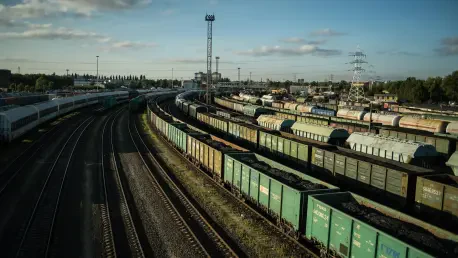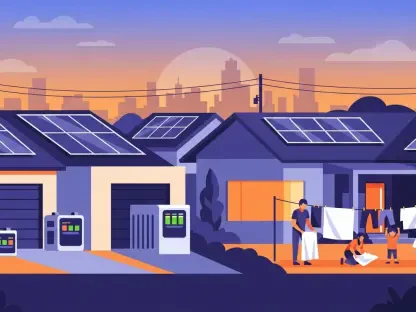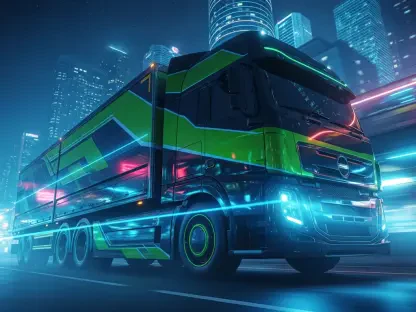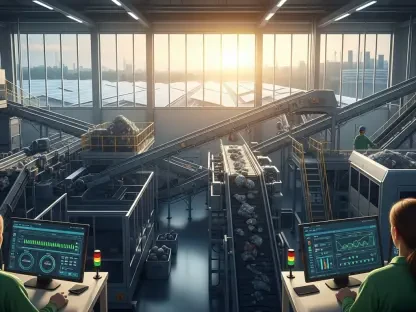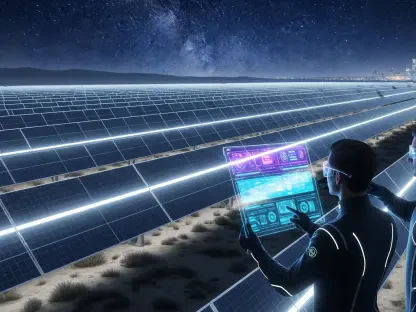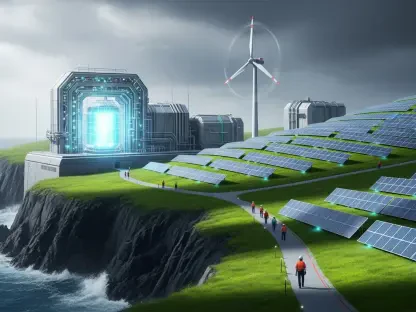The freight transportation industry stands at a pivotal moment as electric trains emerge as a formidable rival to diesel trucks in the short-haul logistics arena, promising a cleaner and more efficient way to move goods across shorter distances. A trailblazing startup, Parallel Systems, is leading this charge with a groundbreaking concept that uses autonomous, battery-powered railcars to rethink freight movement. This innovation arrives amid a growing urgency for sustainable solutions, as environmental concerns and operational inefficiencies continue to plague traditional trucking. With the potential to reshape how goods are transported, this development sparks curiosity about whether electric trains can truly outpace trucks in a market long dominated by road-based logistics. The stakes are high, as this shift could not only reduce pollution but also redefine economic opportunities for communities often sidelined by larger freight hubs.
Pioneering a New Era in Freight Transport
Breaking Away from Traditional Models
Parallel Systems has introduced a radical approach to rail logistics by equipping each railcar with its own battery and autonomous operating system, eliminating the need for a single locomotive to pull an entire train. This design allows railcars to form “platoons” of 20 to 30 units, enhancing aerodynamic efficiency during transit while retaining the flexibility to break into smaller groups or individual cars for specific destinations. Such adaptability addresses chronic inefficiencies in conventional rail systems, where assembling trains and managing transfers often cause significant delays. By enabling faster, more direct routing, this technology could position electric trains as a serious competitor to trucks, particularly in the short-haul sector where speed and precision are paramount. The promise of streamlined operations at freight facilities further bolsters the case for this innovation, potentially cutting down on bottlenecks that have long frustrated shippers and logistics providers alike.
Environmental and Economic Impacts
Beyond operational improvements, the shift to electric railcars offers profound environmental benefits by reducing reliance on diesel trucks, which are notorious for emitting high levels of greenhouse gases and local pollutants. Cleaner air along busy freight corridors could become a reality, benefiting communities that often bear the brunt of transportation-related pollution. Economically, the system is designed to lower costs through energy-efficient travel and the use of compact “microterminals” strategically placed near shippers, minimizing the need for sprawling, land-intensive facilities. Rural areas, in particular, stand to gain from improved access to freight networks via these smaller terminals, which could compete with urban hubs and stimulate local economies. This dual focus on sustainability and equity highlights the broader potential of electric trains to transform not just logistics, but the socioeconomic landscape of underserved regions as well.
The Technology Behind the Innovation
Revolutionizing Rail Design
Parallel Systems’ electric railcars mark a significant departure from traditional rail systems by embedding autonomy and battery power into each individual unit, freeing them from the constraints of a centralized locomotive. This innovative setup allows for dynamic grouping into platoons, optimizing energy consumption and delivery routes with remarkable precision. Research simulations conducted by partnering organizations indicate that this design could slash container delivery times by as much as 70%, a statistic that underscores its potential to disrupt short-haul freight. The ability to operate independently or as part of a larger unit means that railcars can adapt to varying cargo needs without the delays associated with assembling conventional trains. This flexibility positions the technology as a game-changer, capable of meeting the fast-paced demands of modern logistics while maintaining a smaller environmental footprint compared to diesel-powered alternatives.
Engineering Efficiency for the Future
The engineering behind these railcars focuses on fine-tuning critical components such as battery range and platoon configurations to maximize efficiency. Advanced simulations have helped determine that a 500-mile range per charge is achievable without adding unnecessary weight, ensuring that the railcars remain practical for short-haul routes. Optimal platoon sizes have also been calculated to balance speed with energy use, allowing for swift deliveries at minimal cost. This meticulous attention to detail in design and operation reflects a broader trend in transportation toward data-driven solutions that minimize inefficiencies. By addressing logistical pain points like terminal congestion and lengthy transfer times, this technology could redefine expectations for rail freight, offering a scalable solution that competes directly with the immediacy of truck transport. The emphasis on precision engineering signals a shift toward smarter, more sustainable systems in an industry ripe for transformation.
Collaborative Efforts and Support
Partnerships Driving Progress
The journey of Parallel Systems’ electric railcar technology has been significantly strengthened by strategic alliances with key government and research entities, ensuring that the project benefits from both financial backing and technical expertise. The US Department of Energy’s ARPA-E office, alongside the National Renewable Energy Laboratory (NREL), has played a pivotal role by providing substantial funding, including a $4.4 million grant awarded in earlier stages of development. NREL’s sophisticated simulation tools have been instrumental in refining operational aspects such as battery performance and dispatch strategies. These collaborations have enabled precise engineering solutions, like achieving a 500-mile range per charge and determining the most effective platoon sizes for efficient movement. Such partnerships highlight the importance of public-private cooperation in advancing clean technology, paving the way for innovations that might otherwise struggle to reach commercial viability.
Building a Foundation for Adoption
Beyond funding and simulations, these collaborative efforts have focused on creating a robust framework for integrating electric railcars into existing freight networks, addressing potential barriers to widespread adoption. NREL’s involvement has extended to optimizing terminal operations, ensuring that the railcars can seamlessly interact with current infrastructure while minimizing disruptions. This groundwork is crucial for convincing stakeholders in the logistics industry of the technology’s reliability and scalability. Additionally, the technical support provided has helped Parallel Systems anticipate real-world challenges, such as varying cargo demands and regional infrastructure limitations, allowing for proactive adjustments to the system. The emphasis on practical integration demonstrates a commitment to not just innovating, but ensuring that such advancements can be effectively implemented, potentially accelerating the shift away from diesel-dependent transport in short-haul logistics.
Real-World Testing and Future Potential
Demonstration on the Horizon
A critical step toward proving the commercial viability of Parallel Systems’ electric railcars is an upcoming demonstration in Georgia, conducted in partnership with Genesee & Wyoming’s Heart of Georgia operation. This ambitious project spans 160 miles between Pooler and Cordele, unfolding across seven phases with completion targeted for 2026. The initiative, which has received approval from the Federal Railroad Administration, aims to showcase how electric railcars can handle container shipping in a region heavily reliant on trucks. By testing the technology in a real-world setting, this demonstration seeks to validate claims of reduced delivery times and operational efficiency, offering tangible evidence of its potential to disrupt traditional freight models. Success in this endeavor could serve as a catalyst for broader adoption, encouraging other regions and companies to consider electric trains as a viable alternative for short-haul logistics.
Shaping the Future of Logistics
Looking ahead, the implications of this demonstration extend far beyond a single test route, as it could set a precedent for how freight transportation evolves in the coming years with a focus on sustainability and efficiency. If the Georgia project proves successful, it may inspire the development of additional microterminals across rural and urban areas, further decentralizing freight networks and improving access for smaller communities. This could address long-standing inequities in logistics, where larger hubs often overshadow regional needs. Moreover, the environmental benefits of replacing diesel trucks with electric railcars could contribute significantly to national and global emissions reduction goals. As the industry watches this pilot unfold, the outcomes will likely inform future investments and policy decisions, potentially accelerating the transition to cleaner freight solutions and redefining the competitive landscape between rail and road transport for years to come.
